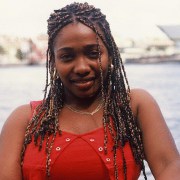 Photo: Getty Images
Photo: Getty Images
Oprah Winfrey once said that a big difference between White and Black women was that Whites obsess over their body size and Blacks obsess over their hair. Most of the audience seemed to agree. On another show, a Black family was being counseled over their obsessive spending. The financial expert told the woman she had to stop paying hundreds a month on her hair care and even Winfrey jumped in with “...you don’t understand! We Black women have to spend time and money on our hair!” Again, the audience was in full agreement.
In fact, ask any Black woman you know about her hair and she’ll probably tell you it’s her "thing". It’s something she has to spend a lot of time and money on and it’s something she has done since she was a toddler. Many a Black woman has a scar or two on her scalp or forehead due to a hot iron being used to straighten her hair as a child. They (not so fondly) remember sitting for long periods of time having their hair braided, wincing at the pulling and overall tightness it caused. While White women worry about their backsides, it’s all about the hair for their Black sisters.
All this hair processing, however, is taking more than just a toll on the time and wallets of Black women. A study from the Cleveland Clinic showed that 25 percent of the over 300 Black women studied had a form of baldness that began at the top of their heads. Of these 25 percent, three-fifths of them had a baldness condition called cicatricial alopecia (known as CCCA) that is linked to the scalp being pulled and dragged which in turn causes bumps and scarring on the scalp that prevents further hair growth. One of the main reasons the balding happens is because these tightly braided weaves and braids are designed to last a long time. This means constant and long-term tugging on the scalp which can lead to blisters and the consequent scarring.
The study showed that the number of braided/weaved women who were seeing this kind of baldness was 10 percent more than in those women who did not get braids or weaves. The cicatricial alopecia is generally seen in women in their 50s but appears to start in their 40s, with cases seen of women as young as their 20s. Doctors warn against women adopting these hairstyles and advise them to take care when tending to the hair needs of children.
More can be read in the online version of Archives of Dermatology, published on Monday, April 11th, 2011.
Tell Us
Do you braid or weave? Have you noticed any subsequent baldness?





Add a CommentComments
There are no comments yet. Be the first one and get the conversation started!